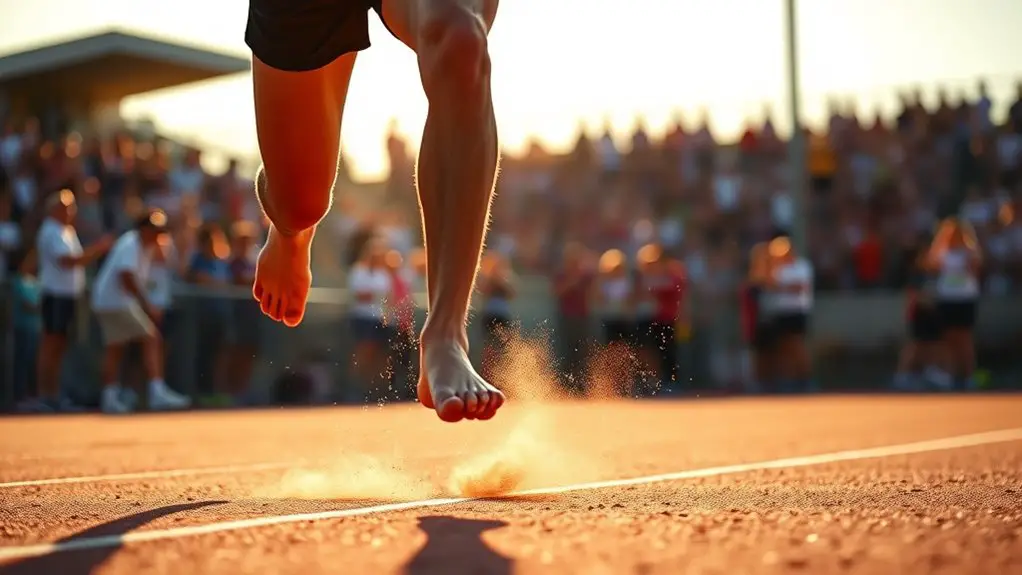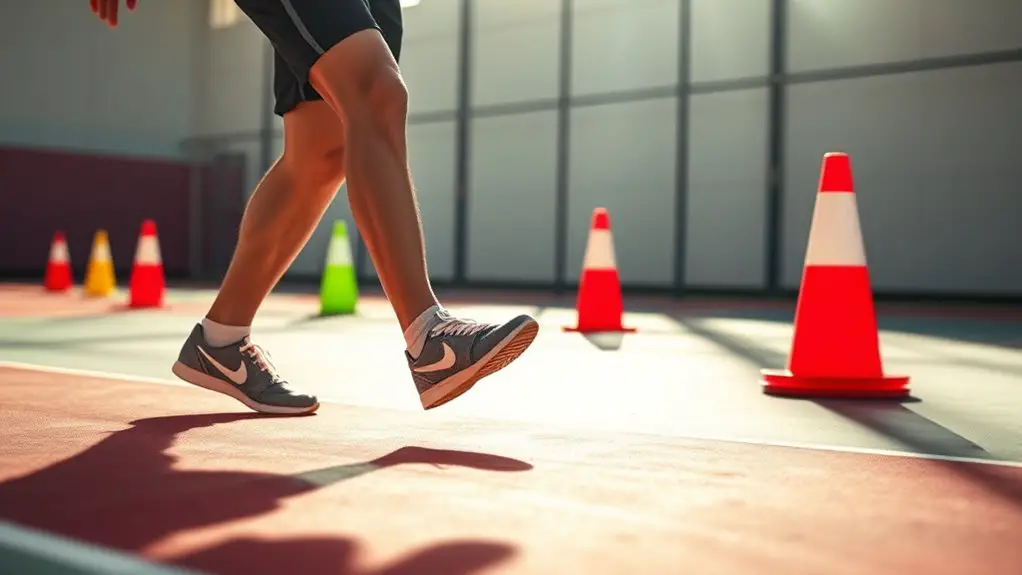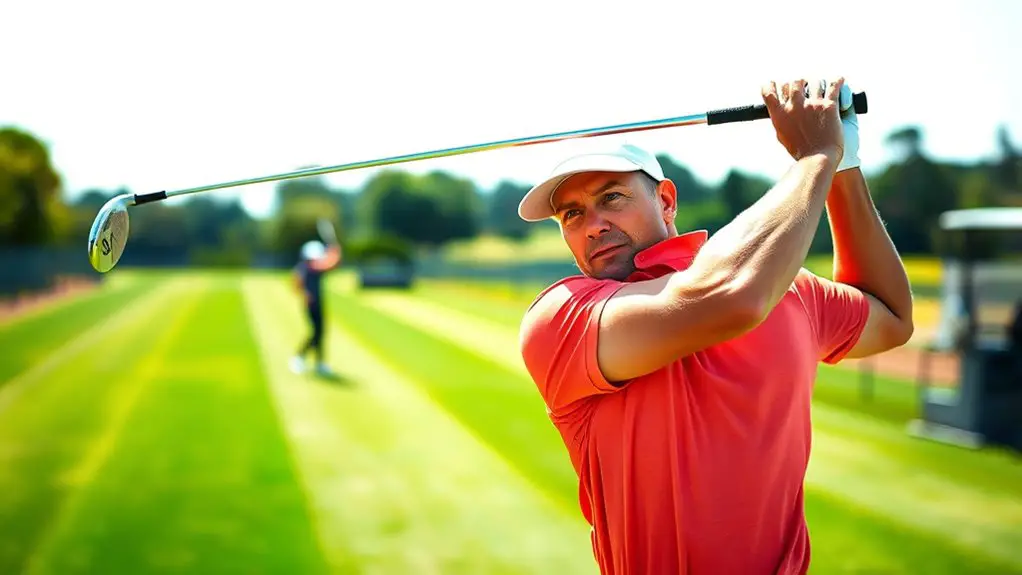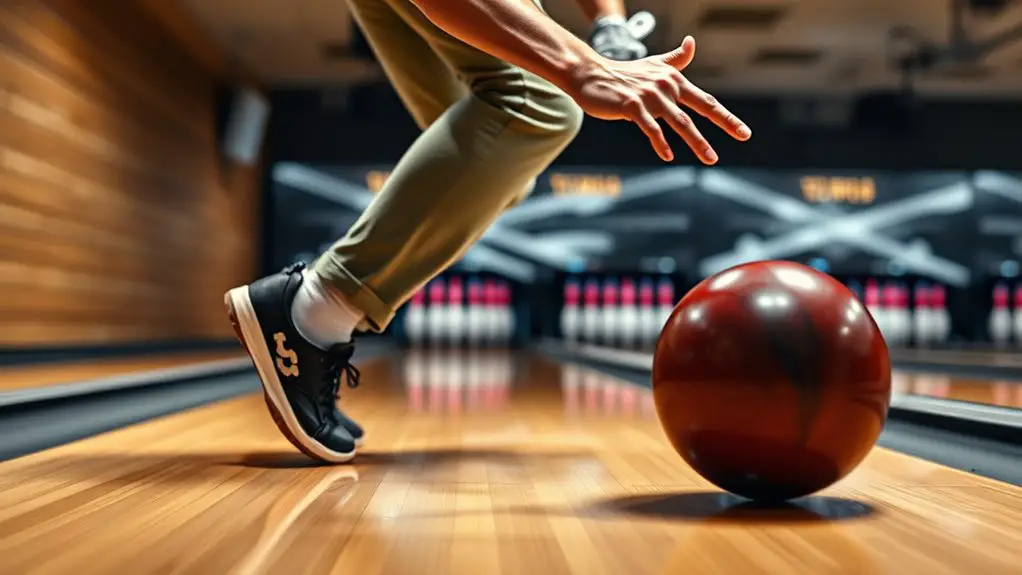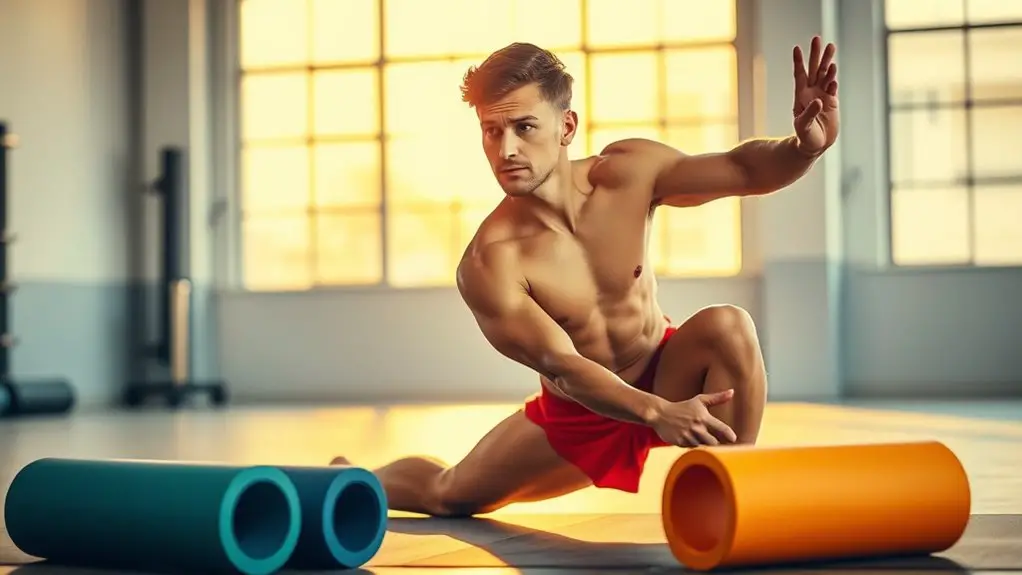Barefoot running can considerably boost your speed training by enhancing your natural biomechanics and foot strength. It encourages a shift from heel striking to forefoot and midfoot landing, leading to better balance and lower impact forces. You'll engage more muscle groups, improving overall stability and efficiency. However, changing requires caution to prevent injuries. As you adapt, you may notice increased agility and speed. Discover more about how to incorporate barefoot running effectively into your training regimen.
Understanding Barefoot Running
Although many runners swear by traditional footwear, barefoot running has gained popularity for its potential benefits. You might feel the urge to connect more deeply with the ground beneath your feet, embracing a more natural running experience. With each step, you can enjoy a sense of liberation, feeling the textures of the trail or pavement, and tuning in to your body's rhythm.
Barefoot running encourages a more instinctive stride, promoting a forefoot or midfoot landing, which can reduce impact and strain over time. You'll discover that this style of running fosters a greater awareness of your surroundings, allowing you to adapt to varied terrains. Plus, it can strengthen your feet and improve balance, enhancing your overall agility. By shedding those restrictive shoes, you're not just changing your footwear; you're commencing a journey towards a more authentic and liberating running experience. Incorporating mobility training can further enhance your performance and reduce injury risk. So, why not give it a try?
The Biomechanics of Barefoot Running
When you shift to barefoot running, you'll notice significant changes in your biomechanics that can enhance your performance. Your foot strikes will become more natural, encouraging you to land on your midfoot rather than your heel. This shift can improve your balance and agility, allowing you to run with greater freedom.
Here's a quick comparison of key biomechanical aspects:
| Aspect | Traditional Running | Barefoot Running |
|---|---|---|
| Foot Strike | Heel Strike | Midfoot/Forefoot |
| Impact Forces | Higher | Lower |
| Muscle Engagement | Less Active | More Engaged |
| Balance and Stability | Limited | Enhanced |
With these changes, you'll likely experience more efficient energy use and reduced injury risk. Embracing barefoot running can truly liberate your stride, allowing you to connect more deeply with your environment. Feel the ground beneath your feet, and enjoy the freedom it brings.
Benefits of Barefoot Running for Speed
Barefoot running can considerably boost your speed by improving your running form and enhancing foot strength. You'll also notice a greater ground feel, which allows you to respond quicker to the terrain. These benefits can help you run faster and more efficiently. Additionally, developing a natural foot strike pattern can further enhance your sprinting performance.
Improved Running Form
Running in minimalist footwear can greatly enhance your form, allowing you to tap into your natural biomechanics. By embracing this style, you'll feel a liberating connection to the ground beneath you, which can lead to significant improvements in your speed. Here's how:
- Increased Agility: You'll find yourself more nimble, making quick adjustments as needed.
- Natural Stride: Your body will instinctively adopt a more efficient, midfoot strike, reducing unnecessary impact.
- Enhanced Balance: Without heavy cushioning, you'll develop a stronger sense of stability, allowing you to soar effortlessly.
Enhanced Foot Strength
With improved running form, you'll also notice significant gains in foot strength, a key advantage of minimalist running. When you ditch the bulky shoes, your feet engage more actively with each stride. This not only builds stronger muscles but also enhances your stability and balance. You'll feel the difference as your arches and toes adapt, allowing for a more natural movement. Stronger feet lead to better propulsion, giving you that extra edge in speed. Plus, as your foot strength increases, you're less likely to suffer from injuries that often plague runners. Embracing barefoot running means freeing your feet, letting them function as they were designed to, ultimately enhancing your speed and performance on the track or trail.
Increased Ground Feel
There's something exhilarating about feeling the ground beneath your feet as you run, and increased ground feel is one of the standout benefits of minimalist footwear. When you shed the bulk of traditional shoes, you connect more deeply with the earth, enhancing your running experience. This newfound freedom can ignite your passion for speed training in several ways:
- Improved Awareness: You'll notice every nuance in your stride, allowing for adjustments that boost your efficiency.
- Natural Movement: Your feet adapt to varied terrains, promoting a more fluid and instinctive running style.
- Enhanced Speed: With better feedback from the ground, you can push your limits and discover your true potential.
Embracing barefoot running lets you reclaim that primal joy in movement.
Challenges and Risks of Barefoot Running
While barefoot running has its perks, it also comes with challenges you shouldn't overlook. You might face an increased risk of injury if your body isn't ready for the change, and adapting to this new style can take time. It's crucial to approach barefoot running with caution and awareness of these potential pitfalls. Additionally, proper warm-ups and strengthening exercises are essential to mitigate the risk of injuries such as tendonitis or sprains.
Increased Injury Risk
Although many runners embrace barefoot running for its potential benefits, it also comes with an increased injury risk that shouldn't be ignored. If you're seeking ultimate freedom in your stride, be aware of these challenges:
- Increased Stress Fractures: Running without cushioning can lead to stress on your bones, making them vulnerable to fractures.
- Ankle Sprains: With less support, your ankles might struggle to stabilize, increasing your risk of sprains during sharp turns.
- Tendonitis: The change in mechanics can put extra strain on tendons, leading to painful inflammation.
While the allure of barefoot running is strong, it's crucial to tread carefully. Embrace your freedom, but remember to protect yourself from potential injuries along the way.
Adaptation Period Challenges
As you shift to barefoot running, you may encounter various adaptation period challenges that can test your resolve. Your feet, used to cushioning, might feel sore as they adjust to the new demands. You could experience calf tightness or even pain as your muscles strengthen and adapt. It is important to listen to your body; pushing too hard can lead to injuries that hinder your freedom to run. Start slow, allowing your feet to acclimate. Embrace shorter distances at first, gradually increasing your mileage. Remember, the journey to barefoot running is about rediscovering your natural stride, so be patient. With time and care, you'll find yourself enjoying the liberating experience of running free, connecting with the ground beneath you.
Scientific Studies on Barefoot Running
Research on barefoot running has gained traction in recent years, revealing intriguing insights into its effects on biomechanics and performance. Scientific studies show that running without shoes can enhance your connection to the ground, giving you a sense of freedom and control. Here are some compelling findings:
- Improved Running Form: Barefoot runners often adopt a more natural stride, helping to reduce injury risk and enhance efficiency.
- Increased Proprioception: You'll develop better awareness of your body's movements, allowing for more fluid and responsive running.
- Strengthened Foot Muscles: Running barefoot can lead to stronger arches and improved overall foot strength, promoting a more stable foundation.
These studies suggest that embracing barefoot running could transform your approach to speed training, allowing you to experience the joy of running in its purest form. So why not explore this liberating experience? You might just find a new passion.
Transitioning to Barefoot Running
Shifting to barefoot running can be an exciting journey, especially if you're ready to enhance your running experience. As you step into this new world, start slowly. Your feet need time to adapt to the different sensations and surfaces. Begin by running on soft grass or a smooth track, allowing your body to adjust without overwhelming it.
Pay attention to your form; a lighter, shorter stride often works best. You might feel a bit wobbly at first, but that's part of the fun! Gradually increase your distance, listening to your body and respecting its limits.
Don't rush the process—embracing the freedom of barefoot running is about enjoying each step. Remember to incorporate strength training for your feet and lower legs to build resilience. A strong core can also enhance your stability and control while running. With patience and dedication, you'll soon find yourself enjoying the liberating feeling of running free, unencumbered by shoes.
Incorporating Barefoot Running Into Training Regimens
Incorporating barefoot running into your training regimen can elevate your performance and enhance your overall running experience. This approach fosters a deeper connection with the ground, igniting your passion for freedom in movement. Here are a few ways to seamlessly integrate it into your routine:
- Start Slow: Begin with short, easy runs on soft surfaces to adapt to the new sensations and build strength in your feet.
- Mix It Up: Alternate between barefoot and traditional running to keep your feet engaged and to prevent fatigue.
- Listen to Your Body: Pay attention to how your feet feel. Allow them to guide your progress, ensuring you're not overdoing it.
Footwear Alternatives and Their Impact
While barefoot running offers a unique way to connect with the ground, exploring footwear alternatives can also greatly impact your performance and comfort. Minimalist shoes, for instance, allow your feet to move more naturally while providing a bit of protection from rough surfaces. This balance can enhance your speed without sacrificing that freedom you crave. On the other hand, traditional running shoes with cushioning can feel like a security blanket, but they may limit your foot's natural mechanics, potentially affecting your stride and speed.
Choosing the right option depends on your running style and goals. If you want to feel the earth beneath your feet while still having some support, look into hybrid options that blend minimalist and traditional features. Ultimately, the best footwear will empower you, letting your body move freely while still offering the protection you need on varied terrains. It's all about finding that sweet spot for your running journey. Additionally, incorporating resistance band training can help enhance strength and flexibility, further improving your overall running performance.
Personal Experiences and Anecdotes From Runners
How do personal experiences shape our approach to running? They're the stories that ignite our passion and transform our journey. When you hear from fellow runners, you often find inspiration to embrace barefoot running. Here are three powerful anecdotes that might resonate with you:
- The Liberation: One runner discovered that shedding shoes helped him feel connected to the earth, enhancing his awareness and freedom while running.
- The Shift: Another shared the struggle of adapting to barefoot running but emphasized how the journey strengthened not just her feet but her determination and resilience.
- The Speed Surge: A seasoned athlete noted that switching to barefoot increased his speed and agility, leading to PRs that reignited his love for the sport.
These personal stories remind us that running isn't just about speed; it's about feeling alive and connected to every stride we take.
Frequently Asked Questions
Can Barefoot Running Improve My Overall Athletic Performance?
Barefoot running can enhance your overall athletic performance by improving your foot strength, balance, and agility. It encourages a more natural running form, which may lead to increased efficiency and reduced injury risk during training.
How Does Barefoot Running Affect Recovery Time After Training?
You might be surprised to learn that barefoot running can actually reduce recovery time after training. By strengthening your feet and improving circulation, you'll feel more refreshed and ready to tackle your next workout sooner.
What Is the Best Surface for Barefoot Running?
When you're barefoot running, the best surfaces are natural ones like grass, dirt trails, or sandy beaches. These surfaces offer cushioning and grip, allowing you to connect with the earth while minimizing injury risks.
Can Barefoot Running Help With Injury Prevention?
Barefoot running's potential for injury prevention isn't just a theory; many believe it strengthens foot muscles and improves biomechanics. If you embrace it, you might find greater freedom in your runs and fewer injuries.
How Does Barefoot Running Influence Running Economy?
Barefoot running can enhance your running economy by promoting a more natural gait, reducing energy expenditure, and improving efficiency. You'll find that this freedom in movement allows for a more fluid and enjoyable running experience.
